A private cloud is a software-defined data center that combines essential hardware and other computing resources into a unified virtualized unit A private cloud’s layer of hardware and networking abstraction – again, provided by software – enables enterprises to scale and provision resources more dynamically than is possible with traditional hardware-centric computing environments.
In contrast to public cloud computing, a private cloud is typically hosted within a company’s firewalls. Alternately, some companies host their private cloud with an external third party provider, which allows these deployments to tap into external compute resources on an on-demand basis.
Protecting your company’s data is critical. Cloud storage with automated backup is scalable, flexible and provides peace of mind. Cobalt Iron’s enterprise-grade backup and recovery solution is known for its hands-free automation and reliability, at a lower cost. Cloud backup that just works.
Ideally, a private cloud allows businesses significant cost savings over legacy hardware-based deployments. It also enables far greater flexibility, and – in contrast to a public cloud – much greater security and privacy.
To help choose a cloud provider – private, public, or hybrid – read our cloud comparison guide.
Contents:
Private cloud is preferred by many companies because it offers a degree of privacy and compliance that may be less challenging – or at least less complicated – than a public cloud. Additionally, a private cloud infrastructure is closer to that of a legacy data center, so plenty of companies see it as an easier transition to cloud computing. Yet despite those advantages, a certain amount of confusion remains about private cloud, its technology and its larger implications for enterprise IT. Here we take an expert look at private cloud:
In this interview, industry expert Andi Mann defines the private cloud and discusses its unique challenges and opportunities. Mann is the co-author of Visible Ops Private Cloud: From Virtualization to Private Cloud in 4 Practical Steps. Formerly an analyst with research firm Enterprise Management Associates, Mann is now Chief Technology Advocate with Splunk.
Despite its significant promise, a private cloud faces challenges. As with traditional deployments, companies must still handle (or pay for) the majority of achitecting and monitoring work themselves. And because private cloud is still emerging technology, a deployment built this year will likely soon call for a revision of some type. For this reason (among others) businesses of varying sizes are opting for hybrid clouds – a term that comprises any number of permutations of private and public clouds.
To be sure, the world of private cloud computing suffers from a phenomenon that few vendors will admit: confusion. Sure, the term private cloud can be defined, yet vendors and pundits tend to disagree on the specifics. For a time, merely using virtualization in your data center meant you had a private cloud; other experts point out that this is only the foundation.
This confusion comes to the fore when businesses go shopping for a private cloud solution. Do you want a full-fledged third party infrastructure as a service solution, or do you simply want to virtualize, say, your southwestern offices? Issues like tiered staff access, control of databases, scheduled provisioning, and application management can quickly spiral into a labyrinthine (and costly) array of choices.
So when planning and building a private cloud – either completely in-house or with any level of vendor involvement – businesses must keep their own goals squarely in place. Why, exactly, are you constructing a new private cloud; what do you want it to do? Looking past the blizzard of choices, the answer to this question is best placed at the very top of your private cloud architecture plan.
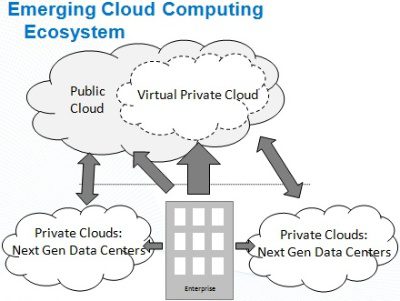
As cloud computing proliferates, private clouds are typically part of a hybrid cloud deployment. (Source: Appistry)
Before building a private cloud, a business must decide: do we want to run it in our own data center, or host it in a third party location?
External private cloud: An externally hosted private cloud is often referred to as a managed private cloud. The concept of an external private cloud causes anxiety among businesses – for good reason. The core rationale a private cloud is so prized is because it offers greater security, privacy and control than a public cloud. So locating a private cloud in an external facility seems to negate this. Among the worries: The issue of data ownership. If, for instance, your private cloud host changes its end users agreements in some onerous way, how easy will it be for you to shift to a new provider?
In effect, your business simply cordons off a section of the third party’s equipment and infrastructure. This saves your business the cash outlay of building/buying this extra equipment and infrastructure, yet also provides (in theory, at least) the same level of privacy and security as would a truly in-house deployment. Many managed clouds enable you to boost your security, allowing you to move specific apps (say, those applicable to mobile workers) into the private cloud; and you can often consume “security as a service,” such as BYOD (bring your own device) security and DLP (data loss prevention) services.
Naturally, your business must select a managed private cloud provider that includes the necessary regulatory compliance security practices to meet rigorous industry standards.
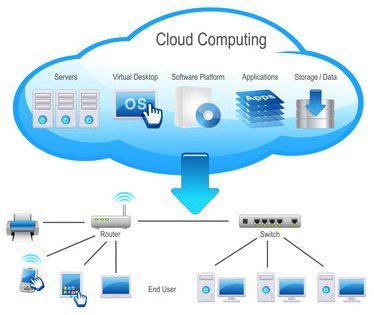
A private cloud comprises a unified, integrated software-defined data center – whether in a company’s in-house data center or in an external facility.
Cost is of course a central concern as you create plans for a private cloud deployment.
And what about “infrastructure anxiety”? That is, while looking for a lower cost vendor, businesses worries about hiring a smaller, less experienced vendor to build such a critical element of its infrastructure. There’s an old saying: “no one ever got fired for buying Microsoft.” Some companies dipping a toe into the new world of cloud computing might lean on older, established names.
In response, Sebesta notes there are different private cloud models today. They’re based on application workloads. “There are some application workloads that, yes, you want the big vendor solution to run on.”
However, “There are other application workloads where putting them on a ‘design for failure’ environment – like an Amazon Web servers equivalent – is the best option.”
The critical question for enterprises, then, is this: what exactly are you planning to run on your private cloud? Will you use it for your mission critical workload, the backbone of your business? Or will you use it for application/resources that you afford to put on ‘design for failure’ infrastructure, one that’s heavily backed up with cheap commodity hardware?
You can architect around the weakness of this latter set-up, Sebesta notes. “You can run a ‘five 9’ application on a ‘three 9’ infrastructure,” he says, referring to the number of 9’s in high availability computing.
The Cloud-in-a-Box solutions from big-name vendors are often designed for higher availability, so they require more hardware and a higher level of engineering. Hosting a business’s mission critical apps on this platform certainly allows greater piece of mind – yet at a higher price point.
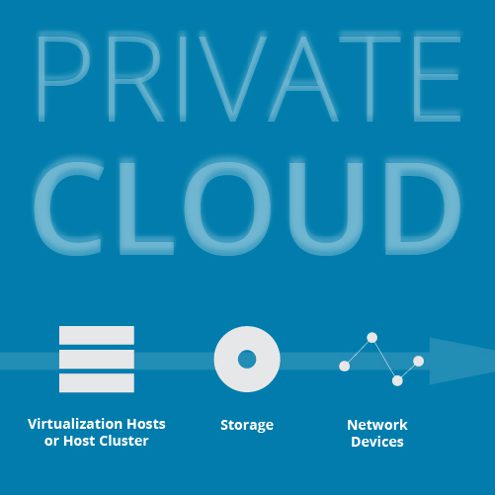
Private cloud combines virtualization hosts, storage and network devices, all into one unified platform.
The terms private cloud and virtualization are often used as synonyms. Many companies take the approach that, if they have virtualized their computing resources, they have implemented a private cloud.
In truth, this isn’t precisely correct.
Consequently, virtualization is a huge cost saver – it’s no surprise that businesses have rushed to deploy virtualization in the datacenter. Note that it was large enterprises equipped with hefty budgets that first rushed to virtualize – for them it was a no-brainer. Smaller and mid-sized companies have been slower to virtualize, because while virtualization provides longer term advantages, initial set-up presents cost and operational headaches.
A virtualized platform provides a datacenter admin with an array of tools to better manage – and often more securely manage – IT resources. The percentage of utilized server compute power jumps markedly; in some cases to the 70-80 percent range. Realize, too, that much more than just servers can be virtualized: storage, networks, applications – many of the elements of IT infrastructure can be virtualized.
This is why IT experts extoll the virtues of the virtualized data center. The old-fashioned hardware-centric data center (which continues to dominate IT) is cumbersome and prone to obsolescence by comparison.
However, virtualization, for all its advantages, isn’t by itself a private cloud. To be sure, virtualization is a necessary foundation for a private cloud. But for a virtualized workload to truly be a private cloud, a company needs to standardize and automate its various workloads. Implicit in the concept of a private cloud is dynamic provisioning and a single pane management of a heterogeneous set of applications. (Not to mention the ability to charge specific business units for the resources they consume. Chargeback is a key advantage of the cloud.)
In short, the visual image of cloud comes into play here: a series of silos built on disparate hardware needs to be turned into a fully integrated and automated computing environment, just as an actual cloud in the sky combines an array of meteorological elements (moisture, temperature) into a single unit – albeit one that changes constantly.
This fully integrated and ever-evolving unit, then, is a private cloud.
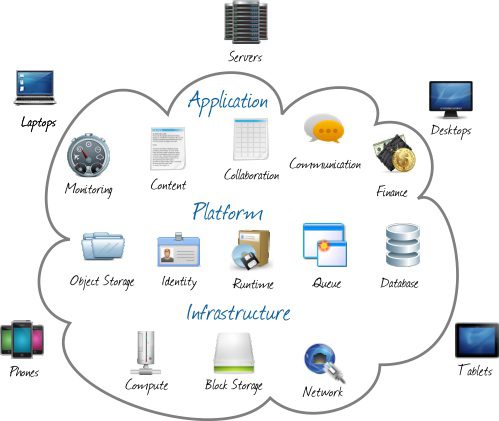
A private cloud involves virtualizing many aspects of data center operation. (Source: CRMNext)
If you talk with consultants who work with clients setting up private clouds, you soon hear horror stories. Businesses rush to get on board with a private cloud and virtualization – they’ve heard of the cost savings – but they don’t really know why.
But hurry, let’s build it!
For instance, one IT department in a northeastern US state (which will remain nameless) spent millions building a state-of-the-art private cloud. And what did the organization do with it? “Oh, we have a few divisions that would like to use it for their apps,” was how a consultant explained its use, noting how amazingly wasteful this is. Unfortunately, this story isn’t an isolated example.
So at the risk of repeating the point, a business that’s weighing deploying a private cloud needs a concrete, well-considered cloud strategy – before starting. It needs to be sure it has a clear answer to (at least) the following extended question:
Other factors to consider as you develop your private cloud strategy:
A Forrester study indicated that in the last 18 months more than 50 percent of the companies surveyed had suffered a security breach. Which brings to mind a full range of legal and compliance issues; how will you handle sensitive user information and financial documents in your private cloud deployment?
And consider this: A big cloud provider’s security budget probably far outweighs yours. They’ll add the newest security technologies quicker than you can. They’ll find and patch vulnerabilities more quickly than you can. They’ve seen more threats and know what to do about them, and they likely have a bigger, more talented security staff.
Bottom line: define a clear private cloud security policy ahead of time – with full awareness of sticky legal and compliance issues – knowing that the fewer personnel with access, the better.
If, for instance, you have a legacy application built in-house (by developers who are long gone) that resides on an aging Unix system, porting this to a private cloud may be more headaches than it’s worth. How about that 1990’s era network you run for your company’s northern region? (The one held together by duct tape.) Can it be virtualized?
Bottom line: Make a complete and clear-eyed inventory of all your compute resources, to see what can and cannot be integrated into your private cloud. Be aware that some companies have more than one private cloud, and that companies run private clouds that incorporate only a portion of their IT resources.
The level of skills required is what prompts many companies to host their private cloud in a third party resource center. In effect, the client company simply extends its firewall and regulatory efforts around this remote facility; a datacenter some hundreds of miles away becomes a “private” facility. The need for skilled staff is also what makes many companies hire high-priced consultants to augment in-house IT pros.
Bottom line: Your decision about staffing – whether you have the right staff, or can afford to hire them – is probably the most critical aspect of your private cloud planning.
A private cloud is always part of a larger infrastructure. Few if any private clouds fulfill all of a business’s computing needs all by themselves (largely because businesses will probably never be able to fit all their compute resources into a single integrated private cloud.)
Consequently, most private clouds are in fact part of a hybrid cloud deployment. A hybrid cloud is a deployment that includes both a private cloud and public cloud; or some form of in-house and externally hosted cloud – the possible permutations are numerous. (In fact, many companies that believe they are not yet in the cloud are, in reality, already relying on cloud resources.)
For instance, many companies use sales automation software from vendors like SugarCRM, Netsuite and salesforce.com. In classic SaaS fashion, this software no longer resides in the datacenter as it once did; instead these vendors charge a per user license fee and maintain the apps themselves.
So where do the customers store the resulting data? Quite likely in a hybrid cloud: data about potential customers could reside in a lower-cost public cloud; but once these prospects convert to paying customers, their sensitive data is moved safely into an in-house private cloud.
This concept of “more sensitive” vs. “less sensitive” types of data drives much of the move toward the hybrid cloud. A company may outsource its email service to a public cloud service, yet store its most strategic R&D work in a private cloud. Or a firm may have a cloud-based business analytics application that contains only limited data sets, to enable fast number crunching over the Web. Some companies outsource parts of their HR work and allow it to be stored on a pubic cloud, yet for regulatory reasons the company stores sensitive personnel data only on a private cloud.
Cloud computing and indeed many of the trends in IT today are focused on replacing or working around the disadvantages of a traditional datacenter. Certainly one of the leading technologies in this effort is Infrastructure as a Service, IaaS.
With IaaS, the entire range of datacenter resources – storage, networking, hardware – is offered on a rental basis. While IaaS offers numerous advantages, it has also created a problem that’s unique to this era in computing. As many company staffers have learned (to the chagrin of the IT department), anyone with a credit card can set up a remote and very robust computing environment. I’ve heard of some companies waking up to realize that there employees have set up more than a dozen separate remote datacenters. All are some form of IaaS.
Despite the problems with rogue accounts, IaaS is an easy and cost effective way for companies to scale out their computing resources on an as-needed basis. It’s particularly useful for short term projects and for seasonal expansion of the datacenter.
Among the many confusions surrounding private cloud is that it can be either in-house (which is the most prevalent) or hosted remotely (with a third party vendor, sometimes called a virtual private cloud). For the sake of this guide, assume that your private cloud will be in-house.
Why exactly are you building a private cloud? To take advantage of shared resources and automation? To more full standardize operations? To make the most of virtualization?
As you clarify your goals, create some metrics that you can use – likely based on greater efficiency and productivity – so you can judge your progress across time.
Get team members on board from multiple divisions, the IT department, the C suite, and the sale staff. This tool will be used by them all – make sure they all understand.
Speaking of staff, here’s a critical question: do you have the in-house expertise that you need? Do your people understand converged infrastructure enough to implement and deploy it in house?
Oh, and don’t necessarily think of savings. There was a time in cloud’s infancy when vendors touted cost savings. Don’t bet on it. Instead, think of leveraging your private cloud for greater competitive advantage across time.
A private cloud has clear advantages over a public cloud in areas like privacy and control and security (though in fact public clouds are probably safer than your company’s datacenter). However, a private cloud cannot scale like a public cloud. A private cloud can’t simply dial up another 40 servers as the holidays approach. Furthermore, your private cloud will not – can not – offer the array of tools offered by large public cloud vendors such as AWS, Azure and Google Cloud.
So as you build your private cloud, think in terms of making it interoperate with the public cloud – that is, think in terms of building a hybrid cloud. Long term (or even mid term) you’re company will be very glad you did.
The first step here is to realize – get ready for it – that the timeline and the budget need to be revised. Building your own private cloud won’t be easy; the very complexity is the reason that AWS, Azure and other public cloud leaders have so dramatically built marketshare. Companies are simply overwhelmed by moving past their core in-house virtualization into true private cloud status.
So learn about virtualization, automation, and converged infrastructure. Understand what goes into rapid re-provisioning. Delve into building a service management tier. Develop a menu of offerings for each of the team members (IT, sales, executives) to use – and make sure the self-service option is clear. Also important: develop a method to chargeback usage to these teams so you can monitor expense.
As you’ve assembled a working private cloud, the technology will change and shift even as you “finish.” New networking platforms like blockchain will emerge, new considerations like the Internet of Things will need to play a role. Tools for automation and self-service will improve over 90-day time spans.
Be aware of this dizzying change even as you begin. No, it doesn’t have to be discouraging, but if you’re not ready for it, it might just be overwhelming. Be prepared. Good luck!
Forecasts of the growth in the private cloud market vary widely, yet they are all driven by one common fact: as companies of various sizes realize that the private cloud is a key next step in IT, the market will grow by leaps and bounds.
Certainly an influx of venture capital is helping fuel growth in cloud computing, with the private cloud being a big beneficiary. Forrester predicts that the global cloud market will grow from its size of $40.7 billion in 2007 to $241 billion in 2020. The research firm also forecasts that the public cloud market will jump from $25.5 billion in 2011 to $159.3 in 2020. An array of cloud sub-markets (management software, virtualization solutions) will grow at various rates.
Similarly, Rightscale predicts that enterprise adoption of private cloud will be 72 percent in 2017. And naturally, the adoption of private cloud is a key component of the hybrid cloud, which many experts expect to be the dominant model in the years ahead.
Among the many factors driving the growth of private cloud computing is a deep concern for security. In an enterprise environment challenged by factors like BYOD and a highly mobile workforce, businesses see the private cloud as a safeguard against data leak and compromised applications.
Indeed, the growth curve for the cloud computing market is expected to keep rising as far as the eye can see. “The IT industry is in the midst of an important transformative period as companies invest in the technologies that will drive growth and innovation over the next two to three decades,” said IDC analyst Frank Gens in a statement. “By the end of the decade, IDC expects at least 80 percent of the industry’s growth, and enterprises’ highest-value leverage of IT, will be driven by cloud services and the other third-platform technologies.”
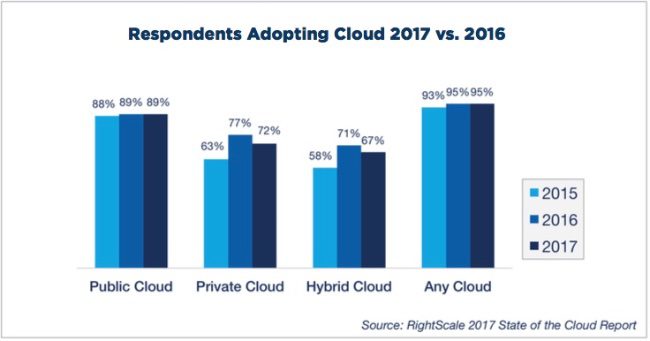
Enterprise adoption rate of the private cloud remains high. Source: Rightscale 2017
If you’re evaluating private cloud vendors, be aware of a controversy that challenges this community of vendors. This argument can be summed up as “which is superior: in-house private clouds or third party remote, managed private clouds?”
Some industry pundits contend that an in-house private cloud is, in fact, merely an extension of the datacenter – and an expensive one.
On one hand, the in-house private cloud is surely popular. Vendors make their pitch: we’ll sell you the hardware, software and virtualization technology, already designed to integrate together, and you install it in-house. Many CIOs welcome the advantages in privacy and security of the private cloud — all under lock and key in-house.
However, claim the pundits, the in-house private cloud is really just another added expense for companies. Purchasing all this hardware and software is not much different than the traditional process of expanding your data center. It’s not as scalable – and not nearly as flexible – as the cloud should be. In a sense it’s the opposite of what the cloud should be: It’s Capex when the cloud should be Opex. (However, to add yet a third point of view: many IT pros say that cloud computing isn’t really about cost reduction – it’s about efficiency and flexibility.)
Instead of an in-house private cloud, a better solution – though, again, opinions vary – is to use a remote third party private cloud provider.
One example among a vast slew of third party providers is Equinix, which has large data centers around the world, ranging from Secaucus, New Jersey to London to Singapore. Equinix offers businesses the ability to set up a private cloud in its data centers. Businesses can establish and cordon off their own hardware, then manager this remote deployment as a private Infratructure as a Service. Equinex has a budding alliance with Amazon: Amazon provides its EC2 customers access to a private cloud center using its AWS Direct Connect service with Equinix. Among the many competitors to Equinix are AT&T (which has a partnership with IBM for private clouds) and Verizon (which partners with VMware for private clouds).
The chief advantage of this remote deployment: the third party provider handles all the headaches of facility management. Scaling out is a matter of buying more capacity, rather than than having to expand or re-architect your in-house facility. Better yet, businesses that don’t have a data center at all can have a private cloud with a remote provider.
Okay, so you want a private cloud – have we got solutions for you. Cloud in a box? In-house private cloud? Remote hosted private cloud in a third party facility? Hybrid cloud? Some combination of these possibilities?
As many businesses begin the private cloud vendor selection process, the names that are most top of mind tend to be the marquee players in the cloud space.
VMware
VMware pioneered virtualization, and some companies still view a virtualized in-house environment as a form of private cloud. And certainly many agree: Forrester named VMware a leader in the private cloud market. VMware says that more than 500,000 enterprises use its technology to power their private clouds.
Microsoft
As Microsoft runs a not-too-distant behind cloud leader AWS, it’s private-public cloud offering provides the company with a real competitive edge. This comes in handy for those many legacy infrastructures that aren’t ready to go all-in with a remote public cloud. In many ways, Microsoft might be the “leader” in the private cloud market, because it’s the top cloud player that offers a strong private cloud platform – AWS does not emphasis private cloud.
Oracle
Oracle – whose CEO, Larry Ellison, so famously used to mock the cloud – now has a plethora of private cloud products, from servers to storage to networking to management software. Oracle even published its own Dummies Guide to Enterprise Cloud Infrastructure, an Oracle Special Edition. Certainly skeptics have notes that Oracle is running behind in the cloud, yet the company is investing deeply in its cloud offerings.
Oracle’s Private Cloud solutions include its Cloud Platform, applications, infrastructure, lifecycle management tools and integration services. It also offers Managed Cloud Services.
IBM
Various research outfits acknowledge IBM as a having a strong presence in private cloud, and certainly the company has a deep commitment to cloud overall. It’s “middle of the pack” in the IaaS market, but likely considered stronger in private cloud.
Is there a better firm when it comes to private cloud for the mainframe? Given the company’s historic strength in the mainframe – which continues to sell – it makes sense that this niche is a standout for IBM.
Dells’ purchase of EMC makes it a true titan in the enterprise IT world, and this extends to private cloud. EMC by itself owns a significant chunk of the private cloud market. The two merged companies are a major force in private cloud hardware market – which, admittedly is essentially a very similar market to the classic in-house datacenter market. Additionally, Dell offers virtual private cloud solutions and a number of cloud consulting services.
HPE
With HP now split into two entities, the slimmed down HPE is arguably better positioned than ever to compete in the cloud market. Indeed, the company is considered a force in private cloud, with Synergy Research reporting that HPE held a whopping 20 percent of the market for private cloud hardware in Q2 2016. The company also offer private cloud software and services, with most of its solutions sold under the Helion moniker.
Be aware when selecting a private cloud solution: The preceding overview of private cloud vendors is not meant to be all-inclusive. The variety of vendor solutions for the private cloud is so remarkably numerous – and so remarkably varied – that customers can easily be confused. Sending out a request for proposal (RFP) can produce a patchwork of possibilities. Adding confusion, some pundits accuse vendors of “cloud washing” – labeling their existing services with the cloud moniker.
If your company is shopping based on type of solution rather than vendor, then likely the Cloud-in-a-Box private cloud solution is an option you’ll consider. This type of offering – focused on pre-architected, easy-set-up deployments – tends to best fit with small and medium-sized businesses; larger enterprise are more likely to custom-build a private cloud.
The bottom line: There’s a private cloud vendor out there for companies of every size and budget. Working with these vendors is a matter of first deciding your goals, then leveraging your budget to get the private cloud deployment that best fits your company’s needs.
The Comprehensive Guide to Cloud Computing [Datamation]
NIST Definition of Cloud Computing [US. Government]
Public, Private Cloud Markets Set to Soar as Enterprise Adoption Grows [eWeek]
The True Value of the Private Cloud [ITBusinessEdge]
How to Build a Private Cloud: Advice from the Experts [Datamation]
Private Cloud Services, Market Analysis, Global Forecasts [IDC]
Blogs: Private Cloud [Forrester]
Private Cloud Blogs [Gartner]
Demystifying Cloud [Enterprise Management Associates]
SEE ALL
Datamation is the leading industry resource for B2B data professionals and technology buyers. Datamation's focus is on providing insight into the latest trends and innovation in AI, data security, big data, and more, along with in-depth product recommendations and comparisons. More than 1.7M users gain insight and guidance from Datamation every year.
Advertise with TechnologyAdvice on Datamation and our other data and technology-focused platforms.
Advertise with Us
Property of TechnologyAdvice.
© 2025 TechnologyAdvice. All Rights Reserved
Advertiser Disclosure: Some of the products that appear on this
site are from companies from which TechnologyAdvice receives
compensation. This compensation may impact how and where products
appear on this site including, for example, the order in which
they appear. TechnologyAdvice does not include all companies
or all types of products available in the marketplace.